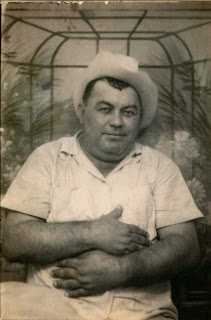 |
| Rayne Tribune Mar 23, 1951 |
Dedans la porte de ma maison, après jongler,
J'sus après jongler si jamais tu va revenir,
Ouais, toi 'tit monde, tu voudrais pour toi-même,
Jolie, conseil t'écoute tes avec moi,
Oh, yé yaille, mon cœur me fais mal,J'ai p'us personne dedans pays, ouais, pour m'soigner.Ouais, toi 'tit monde, te connais pour toi-même,Mérite pas ça, mais, t'après faire, avec ton nègre,Ouais, te voudrais t'en 'venir d'la maison,De faire ton nègre, pour tout ça, toi, t'après faire,Eh, yé yaille, 'garde-donc pourquoi faire,J'ai p'us personne dedans pays, ouais, pour m'soigner.
 |
| Lee Sonnier |
According to some researchers, it would be the first accordion-led Cajun group since before WWII. The song, sung by Blackie Broussard in 1948, would become one of Lawrence Walker's more well known later tunes, the "Evangeline Waltz". Misspelled "Snownier", "Crawley" and "Cajin", the record "La Blues De Cajin" (#1010) discretely displayed the word 'accordion' on the front label. The labels showed the difficulty of getting Cajun spellings printed accurately at pressing facilities away from Cajun country. The title "La Blues De Cajin" reflects it no less obviously than the artist credits to Lee Snownier.1
In the doorway of my house, crying,
Wondering if you'll ever come back,
Yeah, you little everything, you wanted to yourself,
Pretty one, (my) advice, you listen to me,
Oh, yé yaille, my heart aches,I have no one in the countryside, yeah, to take care of me.Yes, you little everything, you know yourself,Don't deserve that, well, what you've done to your man,Yes, you'd like to return home,What's done to your man, all that you're doing,Oh, yé yaille, so, look at what's done,I have no one in the countryside, yeah, to take care of me.
However, Lee never got the exposure he deserved. He would be out shined by a more prominent and popular player named Iry Lejeune, who would make the accordion remain in the spotlight for good.
- Fais Do Do Breakdown - Volume One - The Late 1940's. Liner notes.
- Lyrics by Stephane F
Release Info:
La Blues De Cajin | Fais-Do-Do F-1010-A
Chere Eci Et Chere Laba | Fais-Do-Do F-1010-B
Find:
Fais Do Do Breakdown - Volume One - The Late 1940's (Flyright, 1986)
Acadian All Star Special - The Pioneering Cajun Recordings Of J.D. Miller (Bear, 2011)















